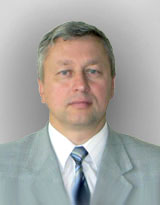Guiding a supersonic controlled object in a multi-position air basing radar
https://doi.org/10.37661/1816-0301-2020-17-2-120-138
Abstract
The possibility of control of a guided supersonic aviation unmanned interceptor on a moving target in an autonomous airborne multi-position radar station has been investigated. To obtain the coordinate information, the algorithm of difference-range finding and difference range-Doppler spatial measurements is selected using a limited number of transmitting positions that do not provide an unambiguous determination of the coordinates and speed of the object with high accuracy. The paper proposes various approaches to eliminate a priori uncertainty regarding the estimated coordinates in a limited set of measuring radio engineering positions.
An analytical method is considered for constructing an optimal state control device for a nonlinear multidimensional and multiply connected dynamic object, taking into account the constraints, which allows one to obtain finite computational relations in a closed algebraic form. The control device was synthesized using measurements in the Cartesian and spherical coordinate systems, several varieties of the combined method of pointing a controlled object to an instant meeting point were obtained. The given guidance algorithms are a generalization of the method of proportional navigation widely used in practice and its modifications. A distinctive feature of the synthesized algorithms is the natural accounting for the nonlinear, multidimensional, and multiply connected structure of the control object, as well as the parameters of unsteady perturbations (acceleration of gravity, projections of the longitudinal acceleration of the object and acceleration of the target’s maneuver) that act in the guidance process.
The unified kinematic differential equations that describe the dynamics of the control object, are obtained, and they can be used to synthesize a controller that operates according to switched or smoothly matched non-stationary optimality criteria (target functions, target integral manifolds). The developed algorithms can be used in the design of autonomous homing and telecontrol systems, implemented in hardware and software both on board an unmanned aerial or artillery interceptor, and as a part of autonomous multiposition airborne radar stations.
About the Authors
V. E. MarkevichBelarus
Vitaliy E. Markevich, Cand. Sci. (Eng.), Leading Researcher
Minsk
V. V. Legkostup
Belarus
Victor V. Legkostup, Postgraduate Student of Belarusian State University of Informatics and Radioelectronics; Junior Researcher
Minsk
References
1. Mizel A. A., Shelestov A. A. Metody optimizacii. Optimization Methods. Part 1. Tomsk, Tomskij mezhvuzovskij centr distancionnogo obrazovanija, 2002, chast' 1, 192 p. (in Russian).
2. Markov L. N. Osnovy postroenija ZRK. Fundamentals of the Design of Antiaircraft Systems. Minsk, Minskoe vysshee inzhenernoe zenitnoe raketnoe uchilishhe, 1980, 162 p. (in Russian).
3. Kolesnikov A. A., Gelfgat A. G. Proektirovanie mnogokriterial'nyh sistem upravlenija promyshlennymi ob''ektami. Designing Multi-criteria Control Systems for Industrial Facilities. Moscow, Energoatomizdat, 1993, 304 p. (in Russian).
4. Kolesnikov A. A. Sinergeticheskaja teorija upravlenija. Invarianty, optimizacija, sintez. Synergetic Theory of Control. Invariants, Optimization, Synthesis. Moscow, Energoatomizdat, Taganrog, Izdatel'stvo Taganrogskogo gosudarstvennogo radiotehnicheskogo universiteta, 1994, 344 p. (in Russian).
5. Markevich V. E. Analiticheskij sintez metoda navedenija sverhzvukovogo bespilotnogo letatel'nogo apparata na osnove mnogomernoj nelinejnoj dinamicheskoj modeli. Analytical Synthesis of a Method of Guidance of the Supersonic Unmanned Aerial Vehicle on the Basis of Multidimensional Nonlinear Dynamic Model. Informatika [Informatics], 2017, no. 2(54), pp. 93–112 (in Russian).
Review
For citations:
Markevich V.E., Legkostup V.V. Guiding a supersonic controlled object in a multi-position air basing radar. Informatics. 2020;17(2):120-138. (In Russ.) https://doi.org/10.37661/1816-0301-2020-17-2-120-138

























